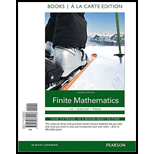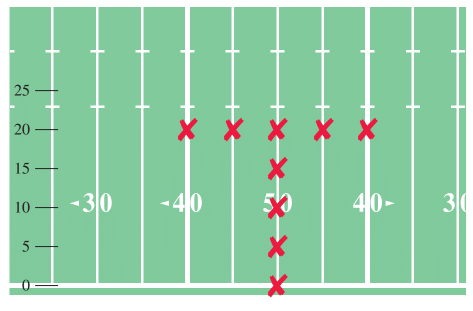
Solve each exercise by using the inverse of the coefficient matrix to solve a system of equations.
Music During a marching band's half-time show, the band members generally line up in such a way that a common shape is recognized by the fans. For example, as illustrated in the figure, a band might form a letter T, where an x represents a member of the band. As the music is played, the band will either create a new shape or rotate the original shape. In doing this, each member of the band will need to move from one point on the field to another. For larger bands, keeping track of who goes where can be a daunting task. However, it is possible to use matrix inverses to make the process a bit easier. The entire process is calculated by knowing how three band members, all of whom cannot be in a straight line, will move from the current position to a new position. For example, in the figure, we can see that there are band members at (50, 0), (50, 15), and (45, 20). We will assume that these three band members move to (40, 10), (55, 10), and (60, 15), respectively. (Note: The x-coordinate 60 is represented by the right side's 40-yard line in the picture.) Source: The College Mathematics Journal

(a) Find the inverse of
(b) Find
(c) Use the result of part (b) to find the new position of the other band members. What is the shape of the new position? (Hint: Multiply the matrix A by a 3 × 1 column
Want to see the full answer?
Check out a sample textbook solution
Chapter 2 Solutions
Finite Mathematics, Books a la Carte Plus MyLab Math Access Card Package (11th Edition)
- No chatgpt pls will upvotearrow_forwardQ/By using Hart man theorem study the Stability of the critical points and draw the phase portrait of the system:- X = -4x+2xy - 8 y° = 4y² X2arrow_forwardThis means that when the Radius of Convergence of the Power Series is a "finite positive real number" r>0, then every point x of the Power Series on (-r, r) will absolutely converge (x ∈ (-r, r)). Moreover, every point x on the Power Series (-∞, -r)U(r, +∞) will diverge (|x| >r). Please explain it.arrow_forward
- Q1: A slider in a machine moves along a fixed straight rod. Its distance x cm along the rod is given below for various values of the time. Find the velocity and acceleration of the slider when t = 0.3 seconds. t(seconds) x(cm) 0 0.1 0.2 0.3 0.4 0.5 0.6 30.13 31.62 32.87 33.64 33.95 33.81 33.24 Q2: Using the Runge-Kutta method of fourth order, solve for y atr = 1.2, From dy_2xy +et = dx x²+xc* Take h=0.2. given x = 1, y = 0 Q3:Approximate the solution of the following equation using finite difference method. ly -(1-y= y = x), y(1) = 2 and y(3) = −1 On the interval (1≤x≤3).(taking h=0.5).arrow_forwardФ sketch stability x= -4x + 2xy - 8 y° = 4 y 2 - x² чуг.arrow_forward2 Q/Given H (x,y) = x² + y² - y² Find the Hamiltonian System and prove it is first integral-arrow_forward
- Q2) A: Find the region where ODEs has no limit cycle: x = y + x³ y=x+y+y³ 6arrow_forwardQ3)A: Given H(x,y)=x2-x+ y²as a first integral of an ODEs, find this ODES corresponding to H(x,y) and show the phase portrait by using Hartman theorem and by drawing graph of H(x,y)-e. Discuss the stability of critical points of the corresponding ODEs.arrow_forwardQ/ Write Example is First integral but not Conservation system.arrow_forward
- Algebra & Trigonometry with Analytic GeometryAlgebraISBN:9781133382119Author:SwokowskiPublisher:Cengage
 College Algebra (MindTap Course List)AlgebraISBN:9781305652231Author:R. David Gustafson, Jeff HughesPublisher:Cengage Learning
College Algebra (MindTap Course List)AlgebraISBN:9781305652231Author:R. David Gustafson, Jeff HughesPublisher:Cengage Learning Holt Mcdougal Larson Pre-algebra: Student Edition...AlgebraISBN:9780547587776Author:HOLT MCDOUGALPublisher:HOLT MCDOUGAL
Holt Mcdougal Larson Pre-algebra: Student Edition...AlgebraISBN:9780547587776Author:HOLT MCDOUGALPublisher:HOLT MCDOUGAL 



